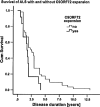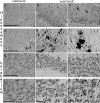Pattern of ubiquilin pathology in ALS and FTLD indicates presence of C9ORF72 hexanucleotide expansion
- PMID: 22426854
- PMCID: PMC3521561
- DOI: 10.1007/s00401-012-0970-z
Pattern of ubiquilin pathology in ALS and FTLD indicates presence of C9ORF72 hexanucleotide expansion
Abstract
C9ORF72-hexanucleotide repeat expansions and ubiquilin-2 (UBQLN2) mutations are recently identified genetic markers in amyotrophic lateral sclerosis (ALS) and frontotemporal lobar degeneration (FTLD). We investigate the relationship between C9ORF72 expansions and the clinical phenotype and neuropathology of ALS and FTLD. Genetic analysis and immunohistochemistry (IHC) were performed on autopsy-confirmed ALS (N = 75), FTLD-TDP (N = 30), AD (N = 14), and controls (N = 11). IHC for neurodegenerative disease pathology consisted of C9ORF72, UBQLN, p62, and TDP-43. A C9ORF72 expansion was identified in 19.4 % of ALS and 31 % of FTLD-TDP cases. ALS cases with C9ORF72 expansions frequently showed a bulbar onset of disease (57 %) and more rapid disease progression to death compared to non-expansion cases. Staining with C9ORF72 antibodies did not yield specific pathology. UBQLN pathology showed a highly distinct pattern in ALS and FTLD-TDP cases with the C9ORF72 expansion, with UBQLN-positive cytoplasmic inclusions in the cerebellar granular layer and extensive UBQLN-positive aggregates and dystrophic neurites in the hippocampal molecular layer and CA regions. These UBQLN pathologies were sufficiently unique to allow correct prediction of cases that were later confirmed to have C9ORF72 expansions by genetic analysis. UBQLN pathology partially co-localized with p62, and to a minor extent with TDP-43 positive dystrophic neurites and spinal cord skein-like inclusions. Our data indicate a pathophysiological link between C9ORF72 expansions and UBQLN proteins in ALS and FTLD-TDP that is associated with a highly characteristic pattern of UBQLN pathology. Our study indicates that this pathology is associated with alterations in clinical phenotype, and suggests that the presence of C9ORF72 repeat expansions may indicate a worse prognosis in ALS.
Figures





References
-
- Al-Sarraj S, King A, Troakes C, Smith B, Maekawa S, Bodi I, Rogelj B, Al-Chalabi A, Hortobagyi T, Shaw CE. p62 positive, TDP-43 negative, neuronal cytoplasmic and intranuclear inclusions in the cerebellum and hippocampus define the pathology of C9orf72-linked FTLD and MND/ALS. Acta Neuropathol. 2011;122:691–702. - PubMed
-
- Bertram L, Hiltunen M, Parkinson M, Ingelsson M, Lange C, Ramasamy K, Mullin K, Menon R, Sampson AJ, Hsiao MY, Elliott KJ, Velicelebi G, Moscarillo T, Hyman BT, Wagner SL, Becker KD, Blacker D, Tanzi RE. Family-based association between Alzheimer's disease and variants in UBQLN1. N Engl J Med. 2005;352:884–894. - PubMed
-
- Boxer AL, Mackenzie IR, Boeve BF, Baker M, Seeley WW, Crook R, Feldman H, Hsiung GY, Rutherford N, Laluz V, Whitwell J, Foti D, McDade E, Molano J, Karydas A, Wojtas A, Goldman J, Mirsky J, Sengdy P, Dearmond S, Miller BL, Rademakers R. Clinical, neuroimaging and neuropathological features of a new chromosome 9p-linked FTD-ALS family. J Neurol Neurosurg Psychiatry. 2011;82:196–203. - PMC - PubMed
-
- Brooks BR, Miller RG, Swash M, Munsat TL. El Escorial revisited: revised criteria for the diagnosis of amyotrophic lateral sclerosis. Amyotroph Lateral Scler Other Motor Neuron Disord. 2000;1:293–299. - PubMed
-
- Cedarbaum JM, Stambler N, Malta E, Fuller C, Hilt D, Thurmond B, Nakanishi A. The ALSFRS-R: a revised ALS functional rating scale that incorporates assessments of respiratory function. BDNF ALS Study Group (Phase III) J Neurol Sci. 1999;169:13–21. - PubMed
Publication types
MeSH terms
Substances
Grants and funding
LinkOut - more resources
Full Text Sources
Other Literature Sources
Medical
Miscellaneous

